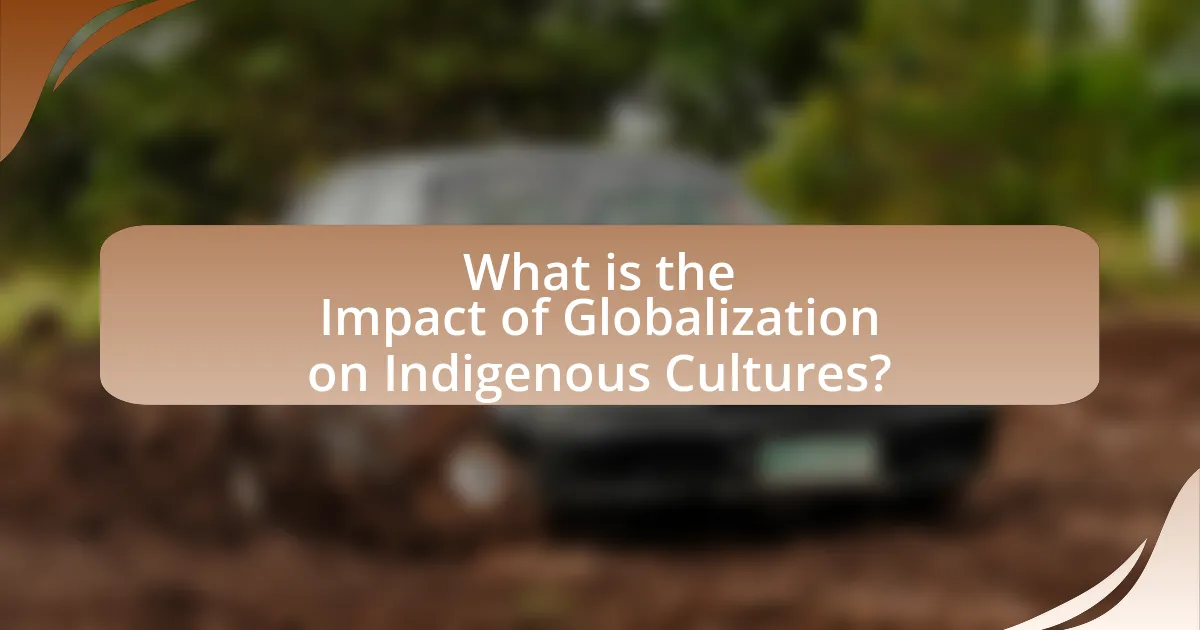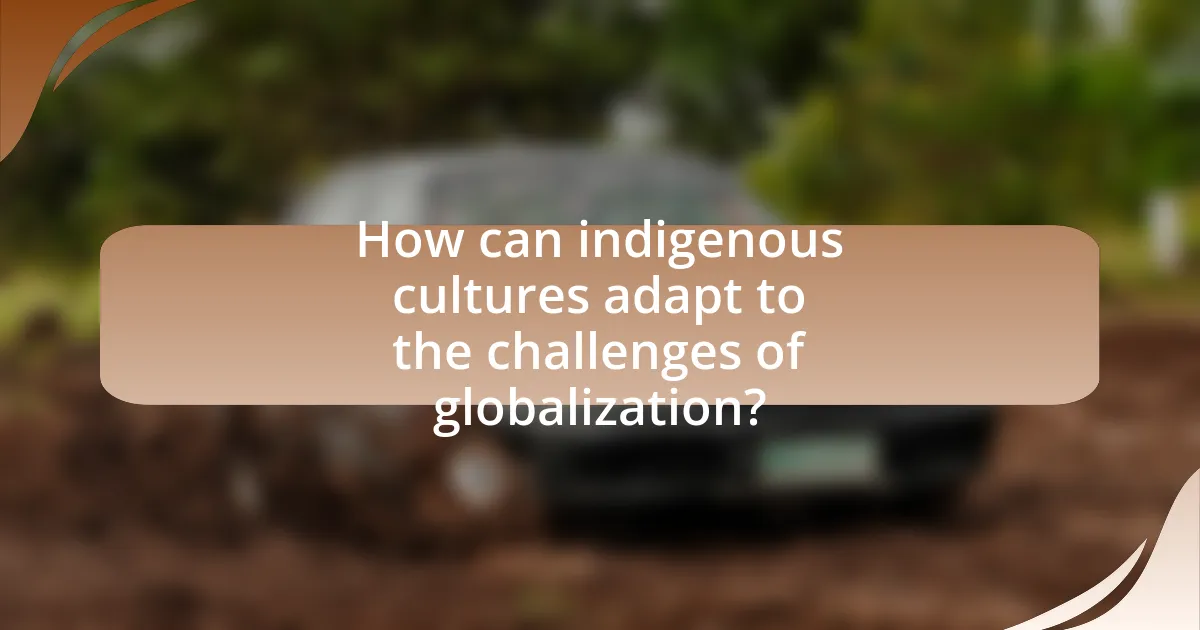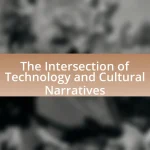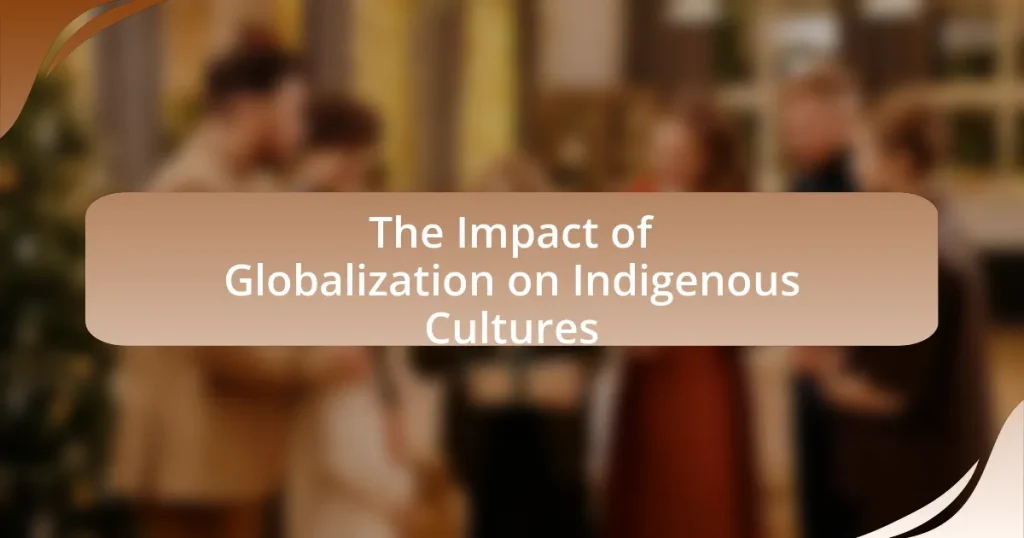The article examines the impact of globalization on indigenous cultures, highlighting the dual challenges of cultural homogenization and economic marginalization. It discusses how globalization promotes the erosion of traditional practices, languages, and identities while also providing opportunities for cultural exchange and economic development. Key factors influencing this dynamic include economic integration, technological advancement, and cultural commodification. The article further explores the implications of globalization for language preservation, economic opportunities, and the strategies indigenous communities can adopt to navigate these challenges effectively.

What is the Impact of Globalization on Indigenous Cultures?
Globalization significantly impacts indigenous cultures by promoting cultural homogenization and economic marginalization. As global markets expand, indigenous communities often face pressure to assimilate into dominant cultures, leading to the erosion of traditional practices, languages, and identities. For instance, the United Nations Educational, Scientific and Cultural Organization (UNESCO) reports that over 2,500 languages are at risk of disappearing, many of which are spoken by indigenous peoples, due to globalization’s influence on communication and cultural exchange. Additionally, economic globalization can result in land dispossession and resource exploitation, undermining indigenous livelihoods and cultural heritage. This dual impact of cultural and economic pressures illustrates the profound challenges that globalization poses to the preservation of indigenous cultures.
How does globalization influence the preservation of indigenous cultures?
Globalization influences the preservation of indigenous cultures by facilitating the exchange of cultural practices and ideas, while simultaneously posing threats through cultural homogenization. On one hand, globalization allows indigenous communities to share their traditions and languages with a broader audience, which can lead to increased awareness and appreciation of their cultures. For instance, the rise of digital platforms enables indigenous artists to reach global markets, thereby promoting their cultural heritage. On the other hand, the influx of dominant global cultures can overshadow indigenous practices, leading to a decline in traditional customs and languages. Research indicates that as global media proliferates, indigenous languages are at risk; UNESCO reports that over 40% of the world’s languages are endangered, many of which are indigenous. Thus, globalization presents both opportunities for cultural exchange and challenges that threaten the survival of indigenous identities.
What are the key factors of globalization affecting indigenous cultures?
The key factors of globalization affecting indigenous cultures include economic integration, cultural homogenization, and technological advancement. Economic integration leads to increased market access for indigenous communities, often resulting in the commodification of their cultural practices and resources. Cultural homogenization occurs as global media and consumer culture spread, diminishing the uniqueness of indigenous identities and traditions. Technological advancement facilitates communication and information exchange, which can empower indigenous voices but also expose them to external influences that may erode traditional practices. These factors collectively challenge the sustainability of indigenous cultures in a rapidly globalizing world.
How do economic changes from globalization impact cultural practices?
Economic changes from globalization significantly alter cultural practices by promoting homogenization and diminishing local traditions. As global markets expand, local economies often shift towards mass production and consumption, leading to the adoption of foreign cultural elements over indigenous practices. For instance, the proliferation of multinational corporations can result in the standardization of goods and services, which often replaces traditional crafts and local customs with global brands. This phenomenon is evidenced by the decline of unique cultural expressions, such as traditional festivals and artisanal crafts, as communities increasingly prioritize economic gain over cultural heritage. Studies indicate that regions heavily influenced by globalization experience a marked reduction in cultural diversity, as seen in the erosion of languages and traditional practices among indigenous populations.
What challenges do indigenous cultures face due to globalization?
Indigenous cultures face significant challenges due to globalization, including cultural erosion, loss of language, and economic marginalization. Cultural erosion occurs as global media and consumer culture promote dominant narratives, overshadowing traditional practices and beliefs. The loss of language is critical, as many indigenous languages are at risk of extinction; UNESCO estimates that one language dies every two weeks, often taking with it unique cultural knowledge. Economic marginalization is evident as indigenous communities struggle to compete in a global economy that favors large corporations, leading to displacement and loss of traditional livelihoods. These challenges threaten the survival and integrity of indigenous identities and ways of life.
How does globalization lead to cultural homogenization?
Globalization leads to cultural homogenization by facilitating the widespread exchange of ideas, values, and practices across borders, resulting in the dominance of a few global cultures over local traditions. This process is driven by factors such as the proliferation of mass media, the internet, and multinational corporations, which promote a standardized cultural narrative that often marginalizes indigenous cultures. For instance, the global popularity of Western media and consumer brands can overshadow local customs and languages, leading to a decline in cultural diversity. Studies have shown that as countries become more interconnected, local identities may erode, with UNESCO reporting that over 40% of the world’s languages are at risk of disappearing due to this cultural convergence.
What role does technology play in the transformation of indigenous cultures?
Technology plays a significant role in the transformation of indigenous cultures by facilitating communication, preserving languages, and enabling economic opportunities. For instance, the use of social media platforms allows indigenous communities to share their cultural narratives and connect with a global audience, thereby fostering cultural exchange and awareness. Additionally, digital tools are employed to document and revitalize endangered languages, as seen in projects like the First Nations Language Preservation Program, which utilizes mobile apps for language learning. Furthermore, technology can enhance economic development through e-commerce, allowing indigenous artisans to sell their crafts online, thus integrating traditional practices with modern market dynamics. These examples illustrate how technology acts as a catalyst for cultural transformation while also posing challenges related to cultural dilution and identity.

What are the positive effects of globalization on indigenous cultures?
Globalization positively affects indigenous cultures by facilitating cultural exchange and economic opportunities. Through globalization, indigenous communities can share their traditions, languages, and art with a broader audience, leading to increased awareness and appreciation of their cultures. For instance, the rise of digital platforms allows indigenous artists to reach global markets, enhancing their economic viability and cultural visibility. Additionally, globalization can promote the preservation of indigenous languages and practices through increased funding and support from international organizations focused on cultural heritage. This interconnectedness can empower indigenous peoples, enabling them to advocate for their rights and maintain their cultural identity in a rapidly changing world.
How can globalization promote cultural exchange?
Globalization promotes cultural exchange by facilitating the flow of ideas, traditions, and practices across borders. This interconnectedness allows individuals and communities to share their cultural heritage through various mediums such as travel, technology, and trade. For instance, the rise of the internet enables instant communication and access to diverse cultural content, allowing people to experience and learn from different cultures without geographical limitations. Additionally, international events like festivals and exhibitions showcase cultural diversity, fostering appreciation and understanding among participants. According to a report by UNESCO, cultural exchange through globalization can enhance mutual respect and cooperation among different cultures, contributing to social cohesion and cultural diversity.
What opportunities arise for indigenous communities through global networks?
Indigenous communities gain access to economic opportunities, cultural exchange, and advocacy through global networks. These networks facilitate the sharing of traditional knowledge and practices, allowing indigenous peoples to promote their cultural heritage on international platforms. For instance, participation in global forums and partnerships can lead to funding for community projects, as seen with initiatives like the United Nations Permanent Forum on Indigenous Issues, which provides a platform for indigenous voices and concerns. Additionally, global networks enable indigenous communities to collaborate with NGOs and other organizations, enhancing their capacity to address social, environmental, and economic challenges.
How does globalization facilitate the revival of indigenous languages?
Globalization facilitates the revival of indigenous languages by increasing access to digital platforms and resources that promote language learning and cultural exchange. The internet allows indigenous communities to share their languages through social media, online courses, and digital archives, which can lead to greater visibility and interest in these languages. For instance, initiatives like the “Indigenous Language Digital Archive” have documented and made accessible numerous indigenous languages, fostering a sense of pride and encouraging younger generations to learn their ancestral languages. Additionally, globalization promotes multiculturalism, which can lead to increased funding and support for language revitalization programs from both governmental and non-governmental organizations.
What economic benefits can globalization bring to indigenous populations?
Globalization can bring significant economic benefits to indigenous populations by providing access to broader markets, enhancing trade opportunities, and facilitating investment in local enterprises. For instance, indigenous communities can leverage globalization to sell traditional crafts and products to international consumers, which can increase their income and promote cultural heritage. Additionally, globalization often leads to infrastructure development, such as improved transportation and communication systems, which can further enhance economic activities. A study by the World Bank indicates that indigenous populations engaged in global trade can experience income growth rates of up to 30%, demonstrating the tangible economic advantages of globalization.
How do tourism and global markets impact indigenous economies?
Tourism and global markets significantly impact indigenous economies by providing both opportunities for economic development and challenges related to cultural preservation. Increased tourism can lead to job creation and income generation for indigenous communities, as seen in regions like the Maori in New Zealand, where cultural tourism has contributed to economic growth. However, reliance on tourism can also result in economic vulnerability and cultural commodification, as indigenous practices may be altered to meet tourist expectations. For instance, a study by the United Nations Permanent Forum on Indigenous Issues highlights that while tourism can enhance local economies, it often risks undermining traditional practices and values, leading to a loss of cultural identity.
What are the implications of fair trade for indigenous artisans?
Fair trade positively impacts indigenous artisans by providing them with equitable compensation and access to global markets. This model ensures that artisans receive a fair price for their crafts, which can lead to improved economic stability and community development. For instance, a study by the World Fair Organization indicates that fair trade practices can increase artisans’ income by 20-50%, allowing them to invest in education and healthcare. Additionally, fair trade promotes cultural preservation by encouraging artisans to maintain traditional crafting techniques, thereby supporting their cultural identity in a globalized economy.

How can indigenous cultures adapt to the challenges of globalization?
Indigenous cultures can adapt to the challenges of globalization by integrating modern technology while preserving traditional practices. This adaptation allows them to maintain cultural identity and engage with global markets. For instance, many indigenous communities have utilized social media platforms to promote their crafts and languages, thereby reaching a wider audience and generating income. Research by the United Nations Educational, Scientific and Cultural Organization (UNESCO) highlights that such strategies not only enhance economic opportunities but also foster cultural exchange and awareness. By balancing tradition with innovation, indigenous cultures can navigate the complexities of globalization effectively.
What strategies can indigenous communities employ to preserve their cultures?
Indigenous communities can employ several strategies to preserve their cultures, including language revitalization, traditional education, and cultural documentation. Language revitalization initiatives, such as immersion programs and community classes, help maintain native languages, which are crucial for cultural identity. Traditional education, where elders teach younger generations about customs, practices, and histories, fosters a sense of belonging and continuity. Cultural documentation through oral histories, art, and digital media ensures that cultural expressions are recorded and accessible, allowing for broader awareness and appreciation. These strategies are supported by research indicating that communities actively engaged in cultural preservation experience stronger social cohesion and resilience against the pressures of globalization.
How can education play a role in cultural preservation?
Education plays a crucial role in cultural preservation by transmitting knowledge, traditions, and languages to future generations. Through formal and informal educational systems, individuals learn about their cultural heritage, which fosters a sense of identity and belonging. For instance, programs that incorporate indigenous languages and cultural practices into school curricula have been shown to enhance cultural pride and continuity among indigenous youth. Research by the United Nations Educational, Scientific and Cultural Organization (UNESCO) highlights that education that respects and integrates local cultures can significantly contribute to the preservation of those cultures in the face of globalization.
What initiatives can support the sustainability of indigenous practices?
Initiatives that can support the sustainability of indigenous practices include the establishment of legal frameworks that recognize and protect indigenous land rights, which are essential for maintaining traditional practices. For example, the United Nations Declaration on the Rights of Indigenous Peoples emphasizes the importance of land rights in preserving cultural heritage and practices. Additionally, community-led conservation programs that integrate traditional ecological knowledge with modern conservation techniques can enhance biodiversity and promote sustainable resource management. Research indicates that such initiatives not only empower indigenous communities but also contribute to environmental sustainability, as seen in the work of the Indigenous Peoples’ Biocultural Climate Change Assessment, which highlights the effectiveness of indigenous stewardship in climate resilience.
What best practices can be adopted for cultural resilience?
Best practices for cultural resilience include the preservation of language, promotion of traditional practices, and fostering intergenerational knowledge transfer. Preserving language is crucial as it embodies cultural identity; for instance, UNESCO recognizes that language loss can lead to cultural erosion. Promoting traditional practices, such as ceremonies and crafts, helps maintain cultural relevance and community cohesion, evidenced by initiatives in various Indigenous communities that have revitalized traditional arts. Fostering intergenerational knowledge transfer ensures that cultural values and practices are passed down, which is supported by research indicating that communities with strong family ties exhibit greater cultural resilience.
How can collaboration with global organizations benefit indigenous cultures?
Collaboration with global organizations can benefit indigenous cultures by providing access to resources, knowledge, and platforms for advocacy. Such partnerships can enhance the preservation of indigenous languages and traditions through funding and educational programs, as seen in initiatives like the United Nations Permanent Forum on Indigenous Issues, which promotes the rights and cultural heritage of indigenous peoples. Additionally, global organizations can facilitate the sharing of best practices in sustainable development, allowing indigenous communities to leverage their traditional ecological knowledge in modern contexts, thereby fostering economic opportunities while maintaining cultural integrity.
What role does community engagement play in cultural adaptation?
Community engagement is crucial in cultural adaptation as it fosters collaboration and understanding between diverse groups, facilitating the integration of new cultural elements while preserving traditional practices. Engaged communities actively participate in dialogues that promote cultural exchange, allowing for the adaptation of customs and values in a way that respects indigenous heritage. Research indicates that communities that prioritize engagement experience enhanced resilience against cultural erosion, as seen in various indigenous groups that have successfully navigated globalization by leveraging local knowledge and practices. For instance, the Maori in New Zealand have utilized community engagement to revitalize their language and traditions in response to external cultural pressures, demonstrating the effectiveness of this approach in maintaining cultural identity amidst globalization.
What practical steps can individuals take to support indigenous cultures in a globalized world?
Individuals can support indigenous cultures in a globalized world by actively engaging in the promotion and preservation of their languages, traditions, and rights. This can be achieved through learning and using indigenous languages, which helps to keep them alive; participating in cultural events and supporting indigenous artists, which fosters cultural expression; and advocating for policies that protect indigenous land and resources, ensuring their rights are respected. For instance, the United Nations Declaration on the Rights of Indigenous Peoples emphasizes the importance of protecting indigenous cultures and languages, highlighting the global commitment to these efforts.










